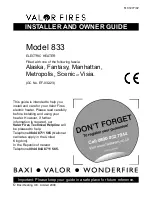
22
To inspect or replace an anode:
The anodes on this heater are easily accessible from the top of the
heater making replacement simple and quick.
1. Turn the heater off per the lighting instructions. Connect a hose to the
drain valve . Locate the hose's discharge in an area where hot water
will not cause any damage or injury.
2. Open the drain valve to flush any sediment out of the bottom of the
heater.
3. Shut off the cold water supply. Make sure all hot water fixtures and
circulating pumps are turned off.
4. Wait for water flow from the hose to stop. Remove the anode using a
socket of the appropriate size Sometimes a pry bar will be required to
loosen the anode plug . Do not use an impact wrench.
5. Inspect and replace the anode as required. Use a pipe tape or sealant
when reinstalling the anode.
6. Close the drain valve . Open a hot water fixture to allow air to escape.
Open the cold water supply to heater and allow the tank to fill. Follow
the lighting instructions.
7. Check your anode and drain valve for leaks.
DRAIN VALVE AND ACCESS PANELS
The heaters are equipped with a 3/4" drain valve.
An access panel covers the cleanout opening in the tank which is sealed
by a gasket and cover, figure 25.
RELIEF VALVE
At least twice a year, the temperature and pressure relief valve should be
checked to ensure that it is in operating condition. To check the relief valve,
lift the lever at the end of the valve several times. The valve should seat
properly and operate freely.
If water does not flow, remove and inspect for obstructions or corrosion.
Replace with a new valve of the recommended size as necessary.
Inspection of the valve should be performed at least every three years. Do
not attempt to repair the valve, as this could result in improper operation
and a tank explosion. In areas with poor water conditions, it may be
necessary to inspect the T&P valve more often than every three years.
CAUTION
BEFORE MANUALLY OPERATING THE VALVE, MAKE SURE THAT A DRAIN
LINE HAS BEEN ATTACHED TO THE VALVE TO DIRECT THE DISCHARGE
TO AN OPEN DRAIN. FAILURE TO TAKE THIS PRECAUTION COULD MEAN
CONTACT WITH EXTREMELY HOT WATER PASSING OUT THE VALVE
DURING THIS CHECKING OPERATION.
If the temperature and pressure relief valve on the heater discharges
periodically or continuously, it may be due to thermal expansion of water in
a closed water supply system, or, it may be due to a faulty relief valve.
Thermal expansion is the normal response of water when it is heated. In
a closed system, thermal expansion will cause the system pressure to
build until the relief valve actuation pressure is equaled. Then, the relief
valve will open, allowing some water to escape, slightly lowering the
pressure.
Contact your water supplier or local plumbing inspector on how to control
this situation.
Two common corrections are listed in the Checklist and Service Information
which appears later in this manual.
ABOVE ALL, DO NOT PLUG THE TEMPERATURE AND PRESSURE RELIEF
VALVE. THIS IS NOT A SOLUTION AND CAN CREATE A HAZARDOUS
SITUATION.
CIRCULATING PUMP
The water heating system may include a circulating pump. Where used, it
should be lubricated as directed by the circulator manufacturer.
VENT SYSTEM
Examine the vent system every 3 months. Points of inspection are as
follows:
1. Check for obstructions and/or deterioration of vent piping and vent
hood. Replace immediately where needed.
2. Vent pipe and vent hood screen should be cleaned of foreign material
and soot. The screen is located inside the vent hood outlet and is
accessible from the outside of the hood. Do not reach inside the vent
hood when the heater is in operation.
3. Check all vent system connections for leakage and reseal as required
using Hi Temp Silicone sealer or equivalent.











































